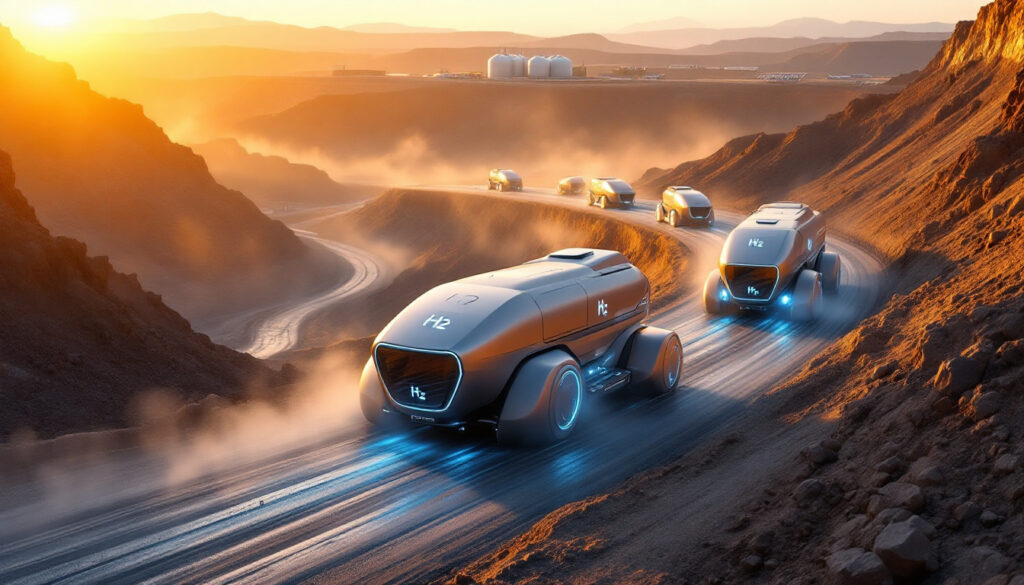What Are Hydrogen Powered Autonomous Trucks?
Hydrogen powered autonomous trucks represent a revolutionary advancement in mining technology, combining zero-emission hydrogen fuel cell technology with cutting-edge autonomous driving capabilities. These sophisticated vehicles are designed specifically to handle the demanding conditions of mining operations while dramatically reducing environmental impact and enhancing operational efficiency.
The Basic Technology
Hydrogen trucks utilize advanced fuel cell technology that converts hydrogen into electricity through an electrochemical process. Unlike conventional diesel engines, these systems generate power by combining hydrogen with oxygen, producing only water as a byproduct. The electricity generated powers electric motors that drive the vehicle, creating a completely emission-free propulsion system.
The integration of autonomous capabilities transforms these vehicles into intelligent machines capable of navigating complex mining environments with minimal human intervention. Using AI in mining energy transition, machine learning algorithms, and advanced sensor arrays, these trucks can operate continuously in challenging conditions while maintaining optimal efficiency.
The technology incorporates redundant systems for safety and reliability, essential features for the demanding environment of mining operations where downtime can cost millions in lost productivity.
Key Advantages Over Traditional Mining Vehicles
The shift to hydrogen powered autonomous trucks delivers multiple compelling benefits for mining operations. Traditional diesel-powered mining trucks emit approximately 100 tons of CO2 annually per 49-ton vehicle. By eliminating these emissions entirely, hydrogen trucks help mining companies meet increasingly stringent environmental regulations and corporate sustainability targets.
Autonomous technology significantly enhances safety protocols through features such as automatic distance maintenance between vehicles, which virtually eliminates the risk of rear-end collisions—a common accident in mining operations. The comprehensive sensor suite provides 360-degree awareness, detecting obstacles and potential hazards that human operators might miss.
The software-defined nature of these trucks enables continuous improvement through over-the-air updates, allowing mining companies to benefit from technological advancements without replacing their entire fleet. This upgradeability extends the useful life of the vehicles while ensuring they operate with the latest safety and efficiency features.
Perhaps most importantly for continuous mining operations, hydrogen fuel cell vehicles can operate 24/7 with minimal downtime. Refueling takes approximately 10 minutes—comparable to diesel refueling and dramatically faster than battery charging—allowing these trucks to maintain high utilization rates essential for profitability in mining operations.
How Do Hydrogen Trucks Address Mining Industry Challenges?
The mining industry faces increasing pressure to reduce its environmental impact while maintaining productivity and addressing safety concerns. Hydrogen powered autonomous trucks offer solutions to these interrelated challenges.
Reducing Carbon Footprint
The global mining industry accounts for approximately 2-3% of worldwide CO2 emissions, with transportation representing 10-20% of the sector's carbon footprint. For major mining operations running large fleets of heavy-duty vehicles, diesel consumption can reach millions of liters annually, creating a significant environmental burden.
Hydrogen trucks eliminate these emissions at the point of use while maintaining the operational capacity mining companies require. A single hydrogen truck operating continuously can prevent the release of hundreds of tons of CO2 annually compared to its diesel counterpart.
Major mining corporations including Rio Tinto, BHP, and Anglo American have established ambitious sustainability targets, with many committing to net-zero operations by 2050 or earlier. The adoption of hydrogen powered fleets represents a concrete step toward achieving these goals while demonstrating environmental responsibility to shareholders, customers, and communities.
Enhancing Safety Through Autonomous Technology
Mining operations present numerous safety hazards, particularly in transportation activities where large vehicles operate in challenging conditions. Autonomous hydrogen trucks address these concerns through multiple advanced safety systems.
The inclusion of lidar, radar, and high-definition cameras creates redundant detection systems that function effectively in all weather and lighting conditions. These sensors constantly monitor the environment, identifying potential hazards faster and more reliably than human operators.
Statistical evidence from early autonomous vehicle deployments in mining shows significant reductions in incidents and accidents. Human error, which accounts for approximately 80% of mining accidents, is substantially reduced through automation of routine driving tasks.
For operations in particularly hazardous environments, fully autonomous capabilities allow trucks to operate in areas that might otherwise pose unacceptable risks to human drivers, improving both safety and productivity.
Solving Labor Challenges in Remote Locations
Remote mining operations frequently struggle with workforce recruitment and retention. The isolated locations, harsh environments, and demanding schedules make attracting qualified personnel difficult and expensive.
Autonomous hydrogen trucks help address these challenges by reducing the total number of drivers required while improving the working conditions for remaining operators. The potential for "road train" configurations—where a single lead driver controls multiple following autonomous trucks—multiplies the productivity of each human operator.
When human operation is required, the modern, ergonomic single-seat cockpit design offers improved comfort and reduced fatigue. Digital interfaces and assisted driving features make operating these vehicles less physically demanding than conventional mining trucks, helping attract younger workers to the industry.
Industry experts note that mining companies operating in remote locations can save millions annually in personnel-related costs through autonomous vehicle implementation, including reduced housing, transportation, and premium pay expenses.
What Makes Hydrogen Power Ideal for Mining Operations?
While various alternative power sources exist for mining vehicles, hydrogen offers specific advantages that make it particularly well-suited for the demanding requirements of mining operations.
Operational Advantages Over Battery Electric Vehicles
Although battery electric vehicles (BEVs) have gained traction in many transportation sectors, hydrogen fuel cell vehicles outperform them in several critical areas for mining applications. The high energy density of hydrogen storage systems enables these trucks to carry heavier loads over longer distances without compromising performance.
Unlike battery systems that experience significant range reduction in extreme temperatures, hydrogen fuel cells maintain consistent performance regardless of environmental conditions—a crucial advantage for mining operations in arctic regions or desert environments where temperatures can fluctuate dramatically.
The rapid refueling capability (approximately 10 minutes) contrasts sharply with the 3-4 hours typically required for battery recharging, allowing hydrogen trucks to maximize operational uptime. With a standard 59 kg hydrogen capacity, these vehicles achieve approximately 700 km range while consuming roughly 8 kg of hydrogen per 100 km.
This combination of quick refueling and extended range makes hydrogen power particularly suitable for continuous mining operations where vehicle availability directly impacts productivity and profitability.
On-Site Hydrogen Production Possibilities
One compelling advantage of hydrogen technology for mining is the potential for on-site fuel production, reducing dependency on external fuel supplies that may be difficult to transport to remote locations.
Mining operations can implement various hydrogen production methods based on available resources and local conditions:
- Blue hydrogen production utilizes natural gas (often already available at mining sites for power generation) with carbon capture technology to minimize emissions.
- Green hydrogen production through electrolysis powered by solar installations offers a completely renewable solution, particularly advantageous for mining operations in sun-rich regions.
- For coal mining operations, hydrogen can be extracted from coke oven gas, creating a circular energy system that utilizes byproducts from existing processes.
Recent technological advancements have significantly reduced the cost of electrolyzers, making on-site hydrogen production increasingly economical. In optimal conditions, green hydrogen production costs can reach as low as $0.50 per kilogram—well below the approximately $2 per kilogram break-even point compared to diesel fuel.
Refueling Infrastructure Requirements
Implementation of hydrogen refueling capabilities at mining sites utilizes standardized equipment compatible with existing hydrogen distribution networks. The industry has standardized around C5 megapascal/H17 megapascal systems, ensuring compatibility with hydrogen trucks from various manufacturers.
The same refueling technology has been successfully deployed for commercial customers including DHL, Aramco, and SABIC, demonstrating its reliability in industrial applications. For remote mining operations, modular hydrogen production and refueling stations can be transported and installed relatively quickly, enabling a phased transition to hydrogen power.
Industry experts note that the capital investment for hydrogen infrastructure can be offset by eliminating the need for diesel storage, transport, and handling facilities, which require significant safety measures and environmental protections.
How Does the Economics of Hydrogen Trucks Compare?
While environmental benefits drive much of the interest in hydrogen technology, the economic case for hydrogen powered autonomous trucks continues to strengthen as technology advances and scales.
Total Cost of Ownership Considerations
Fuel typically represents 20-30% of annual operating expenses for heavy mining vehicles, making fuel efficiency and cost critical considerations. The economics of hydrogen power depend significantly on hydrogen production costs, which vary based on production method and scale.
At approximately $2 per kilogram, hydrogen reaches cost parity with diesel fuel for equivalent work output. In regions with abundant solar resources, green hydrogen production can achieve costs as low as $0.50 per kilogram, creating substantial operating cost advantages over diesel.
While the initial purchase price of hydrogen trucks currently exceeds that of diesel equivalents, the gap continues to narrow as production scales increase. Total cost of ownership analysis must also consider maintenance advantages of fuel cell electric drivetrains, which have fewer moving parts and reduced service requirements compared to internal combustion engines.
Additional economic benefits accrue from carbon credits and regulatory compliance. As carbon pricing mechanisms expand globally, the emission reductions achieved through hydrogen trucks translate directly to financial benefits through reduced carbon taxes or increased credit values.
Environmental Impact Across Scopes
Comprehensive environmental assessment requires examining emissions across all scopes—direct operational emissions (Scope 1), indirect energy emissions (Scope 2), and supply chain emissions (Scope 3).
Hydrogen trucks eliminate Scope 1 emissions entirely, producing only water during operation. However, the full environmental profile depends significantly on the hydrogen production method:
- Green hydrogen produced through solar-powered electrolysis offers the lowest overall carbon footprint, with potential lifecycle emission reductions exceeding 90% compared to diesel.
- Blue hydrogen from natural gas with carbon capture represents an intermediate option, typically reducing lifecycle emissions by 60-80% depending on the efficiency of carbon capture.
- Hydrogen derived from coal-based processes without carbon capture offers less significant environmental advantages and may not meet sustainability targets of leading mining companies.
For mining companies committed to science-based emission reduction targets, the source of hydrogen becomes a critical consideration in achieving meaningful environmental improvements.
Weight and Payload Considerations
Maintaining payload capacity is essential for mining economics, as reduced carrying capacity directly impacts productivity. Hydrogen powered trucks achieve comparable weight to diesel equivalents, preserving payload capacity while delivering environmental benefits.
In standard road-legal configurations, these trucks typically feature a 10-ton tractor head combined with an 8-ton trailer, totaling 18 tons. This allows approximately 30 tons of payload capacity while remaining within the 49-ton gross vehicle weight limits common in many jurisdictions.
For off-road mining applications where weight restrictions may be less stringent, specialized hydrogen truck configurations can achieve even greater payload capacities, matching or exceeding those of conventional mining vehicles.
What Real-World Applications Are Already Underway?
Hydrogen powered autonomous trucks have moved beyond theoretical concepts and are now operating in commercial applications, with mining-specific implementations expanding rapidly.
Current Commercial Deployments
Several major companies have already implemented hydrogen trucks in their operations, providing valuable real-world validation of the technology:
- In Saudi Arabia, organizations including Aramco, DHL, SABIC, and NEOM have deployed hydrogen trucks for heavy-duty transportation applications.
- European customers, including Highland, have integrated hydrogen vehicles into their logistics and transportation operations.
- Throughout Asia, multiple companies are adopting hydrogen transportation technology, driven by national hydrogen strategies and emission reduction mandates.
These early deployments have demonstrated the reliability and performance of hydrogen fuel cell technology in demanding commercial applications, establishing confidence for mining-specific implementations.
Mining-Specific Implementation Potential
The versatility of hydrogen fuel cell technology extends beyond transportation trucks to various mining equipment. Mining companies are exploring hydrogen power for excavators, loaders, and other heavy machinery traditionally powered by diesel engines.
Hydrogen systems can replace diesel generators in existing mining equipment through retrofit programs, offering a transitional approach that extends the useful life of current assets while reducing emissions.
The technology proves suitable for both in-mine operations and road transportation to processing facilities, providing a comprehensive solution for mining logistics. For underground mining operations, the zero-emission nature of hydrogen vehicles eliminates air quality concerns associated with diesel exhaust, potentially reducing ventilation requirements and associated energy consumption.
Future Development Roadmap
The evolution of hydrogen powered autonomous trucks for mining applications continues along several development pathways:
- Expanded autonomous capabilities specifically designed for mining environments, including automated loading and unloading procedures.
- Integration with mine operation management software to optimize vehicle routing, scheduling, and maintenance.
- Increased hydrogen storage capacity and improved fuel cell efficiency to extend operational range and reduce refueling frequency.
- Development of standardized hydrogen infrastructure suitable for rapid deployment at remote mining sites.
Industry partnerships between mining companies, vehicle manufacturers, and hydrogen technology providers are accelerating these developments, with several pilot projects transitioning to full-scale implementations within the next 1-3 years. Furthermore, digital transformation in mining continues to create new opportunities for integration and optimization of these advanced vehicles.
FAQ About Hydrogen Powered Autonomous Trucks in Mining
How do hydrogen trucks compare to battery electric vehicles for mining?
Hydrogen trucks offer several advantages over battery electric vehicles in mining applications, including better performance under heavy loads, consistent range regardless of temperature, significantly faster refueling (10 minutes vs. 3-4 hours), and suitability for 24/7 operations with minimal downtime. While battery electric vehicles may offer higher energy efficiency in ideal conditions, the operational requirements of mining—including continuous heavy-duty use and operation in extreme environments—often favor hydrogen technology.
What is the range of a hydrogen powered mining truck?
With a standard configuration of 59 kg hydrogen capacity, these trucks can travel approximately 700 kilometers before needing to refuel, consuming roughly 8 kg of hydrogen per 100 kilometers. Range varies based on load, terrain, and driving conditions, but hydrogen trucks maintain more consistent performance across different environmental conditions compared to battery alternatives. Extended range configurations with larger hydrogen storage capacities are available for operations requiring greater distance between refueling points.
How is hydrogen produced for mining truck operations?
Hydrogen can be produced through multiple methods including: blue hydrogen from natural gas conversion with carbon capture, green hydrogen from solar-powered electrolysis, or extraction from coke oven gas at coal mines. Each production method offers different environmental and economic profiles. Mining operations increasingly favor on-site hydrogen production to reduce transportation costs and enhance energy security, particularly in remote locations where fuel delivery presents logistical challenges.
What safety features do autonomous hydrogen trucks provide?
These trucks incorporate multiple safety systems including automatic distance keeping, 360° environmental awareness through lidar, cameras and radar sensors, collision prevention systems, and the potential for fully autonomous operation in controlled mining environments. Redundant systems ensure reliability, with multiple sensors and processors providing backup capabilities. Additionally, digital twins in mining can be used to simulate and optimize safety protocols before implementation. Hydrogen storage systems include sophisticated safety features such as leak detection, pressure management, and impact protection designed to meet or exceed the safety standards of conventional fuel systems.
With decarbonisation in mining becoming increasingly important, hydrogen powered autonomous trucks represent a crucial technology for achieving green transformation in mining. According to recent autonomous hydrogen truck test results in China, these vehicles have demonstrated impressive operational capabilities, while Fortescue's hydrogen-powered truck prototype represents another significant advancement in real-world applications.
Want to Discover the Next Big Mining Success Before Others?
Stay ahead of the market with Discovery Alert's proprietary Discovery IQ model, which instantly notifies you about significant ASX mineral discoveries as they happen, providing a crucial edge for both short-term traders and long-term investors. Explore historic examples of exceptional returns from major discoveries at our dedicated discoveries page and begin your 30-day free trial today.




